http://www.rhci-online.net/radiogram/radiogram.htm
|
RSID: <<2018-11- 25T11:54Z MFSK-32 @ 6005000+1500>>
START
IBC - ITALIAN BROADCASTING CORPORATION
mail:
ibc@europe.com
|
|
http://www.rhci-online.net/radiogram/radiogram.htm
|
RSID: <<2018-11- 25T11:54Z MFSK-32 @ 6005000+1500>>
START
IBC - ITALIAN BROADCASTING CORPORATION
mail:
ibc@europe.com
|
|
RSID: <<2018-11-24T13:30Z
MFSK-64
@ 11600000+1500>>
It is never a good idea to take a selfie on a railroad track, but
many tourists do so on Hanoi's narrow "Train Street" (Ngo 224 Le
Duan) ...
|
Sending Pic:116x150C;
|
https://cnn.it/2KnIEKb
and
https://bit.ly/2FzbGaW
Please report decode to
themightykbc@gmail.com
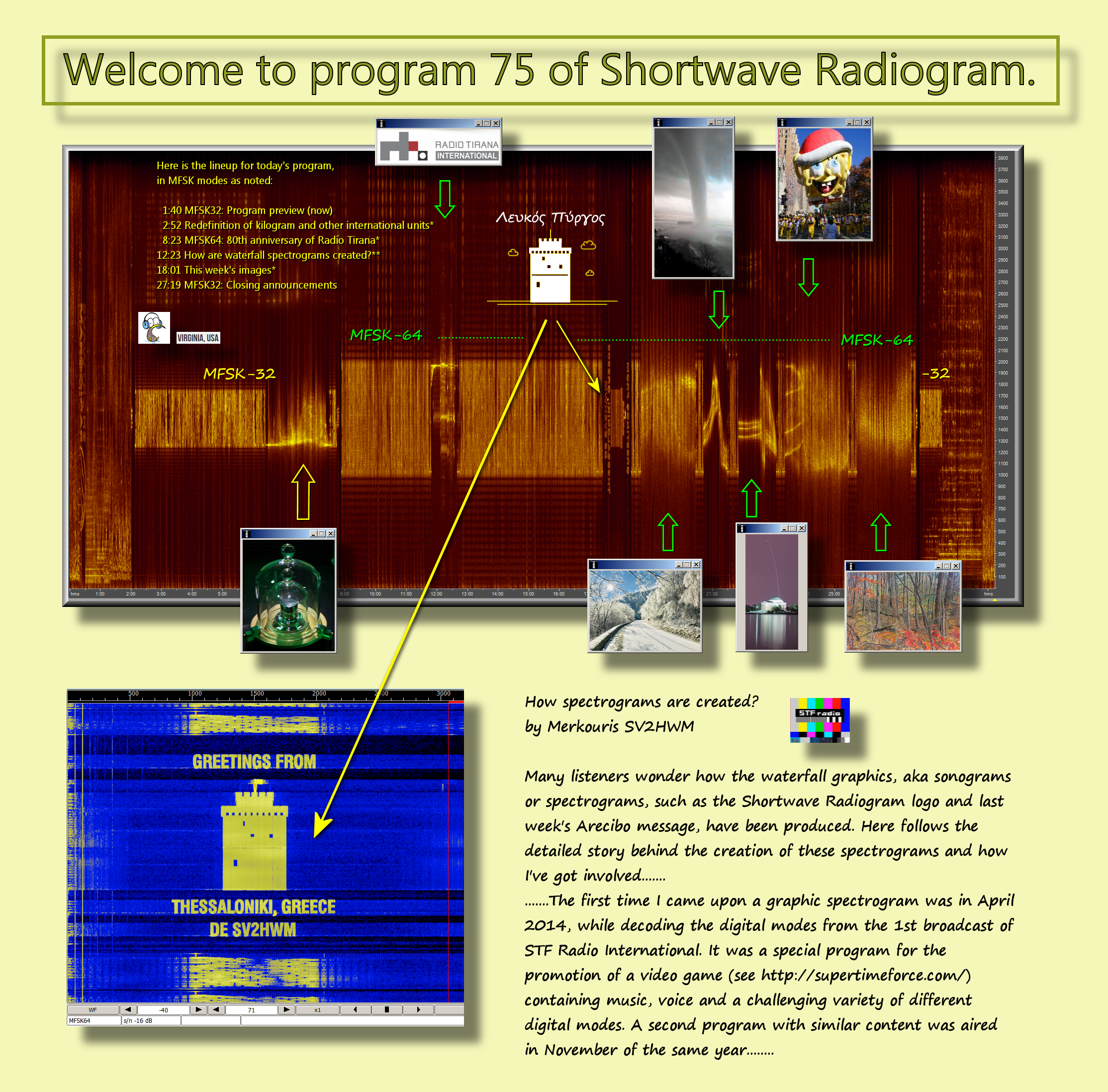
RSID: <<2018-11-23T20:31Z MFSK-32 @ 7780000+1500>>
Welcome to program 75 of Shortwave Radiogram.
I'm Kim Andrew Elliott in Arlington, Virginia USA.
Here is the lineup for today's program, in MFSK modes as noted:
1:40 MFSK32: Program preview (now)
2:52 Redefinition of kilogram and other international units*
8:23 MFSK64: 80th anniversary of Radio Tirana*
12:23 How are waterfall spectrograms created?**
18:01 This week's images*
27:19 MFSK32: Closing announcements
* with image(s)
** followed by spectrogram
Please send reception reports to
radiogram@verizon.net
And visit http://swradiogram.net
Twitter:
@SWRadiogram
VOA NEWS
Quantum Mechanics Will Be Used to Determine Weight and
Measurement Standards
Rick Pantaleo
VOA Science World Blog
16 November 2018
What makes a kilogram a kilogram?
Since the late 19th century the standard, which a kilogram has
been measured, has been based on a chunk of platinum-alloy,
called Le Grand K, that's held at the International Bureau of
Weights and Measures laboratory in Sèvres, France.
According to the Encyclopedia Britannica, a kilogram was
originally intended to be equal to the mass of 1,000 cubic
centimeters of water.
But now a group of delegates, representing 57 countries, at the
26th General Conference of Weights and Measures, have voted to
redefine four of the International System of Units - the kilogram
- measurement of mass, the ampere - current measurement, kelvin -
temperature and the amount of substance known as the mole.
Scientists say they used the constants and equations of quantum
mechanics to develop the new standards.
Rather than base these measurements on archaic standards, such as
the Le Grand K, they will be defined by natural phenomena.
The new kilogram standard, for example, the International Bureau
of Weights and Measures says it will be based on three basic
quantum constants - the Planck constant, the speed of light and
the natural microwave radiation of the cesium atom.
The bureau says these new methods of determining measurement
standards will be a million times more stable than those based on
the old methods.
The new standards are said to go into effect in May, 2019.
https://blogs.voanews.com/science-world/2018/11/16/quantum-mechanics-will-be-used-to-determine-weight-and-measurement-standards/
See also:
https://www.nist.gov/news-events/news/2018/11/historic-vote-ties-kilogram-and-other-units-natural-constants
Image: The platinum-iridium kilogram K92 at the U.S. National
Institute of Standards and Technology ...
Sending Pic:185x224C;
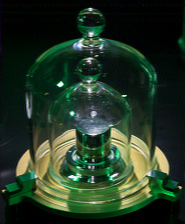
Shortwave Radiogram now changes to MFSK64 ...
RSID: <<2018-11-23T20:38Z
MFSK-64 @
7780000+1500>>
This is Shortwave Radiogram in MFSK64
Please send your reception report to radiogram@verizon.net
From Radio Tirana International:
80 years of Radio Tirana
November 2018
Radio Tirana has an 80 year history, dating back to 28 November
1938. It was the first Albanian radio station launched by King
Zog I and Queen Geraldine in a ceremony at Tirana City Hall of
that time. A year earlier, a shortwave transmitter with a power
of 3 kW at 40 meters was put in operation in a building at Kont
Urani Street (Tirana) and intended mainly for communication, but
was also used to broadcast 3 hours of programs per day. The first
broadcast consisted of choral singing, where Jorgji Truja and
Marije Kraja sang an introductory piece, followed by the unique
timbre of Kaliopi Nushi's voice who pronounced the following
phrase: "Ju flet Tirana" (English: This is Tirana speaking). This
moment officially marked the first broadcast of Radio Tirana.
During the Italian invasion, after 7 April 1939 this radio was
used to raise the awareness of the people to take the weapons and
to protect the country. It continued to broadcast, but during
the German invasion, on 17 November 1943, the radio was directed
by Germans. Only a year after that day, on 17 November 1944, the
partisans took the control of Radio Tirana.
During that time it became very popular. It was like a fantastic
premiere every night, with partisan songs, folk music interpreted
in the studio, and then continued with the beautiful voices of
the singers Tefta Tashko Koco, Marie Kraja, Kristaq Antoniu etc.
The war was over and the people felt this through the optimism
spread by Radio Tirana.
Despite the country's tiny size and isolationist policies, Radio
Tirana was a major international broadcaster during the Cold War.
Its programs had a reputation for being little more than dull
propaganda.
During Albania's alliance with China in the 1960s and 1970s,
Radio Tirana had to walk a fine line between being anti-West
whilst also being anti-Soviet. As such, Radio Tirana kept close
to the official policy of the People's Republic of China, which
was also both anti-West and anti-Soviet whilst still being
socialist in tone. Following the break with China, the policy of
programs still remained Marxist-Leninist in nature. In 1987, 66
hours of programs were broadcast in 20 foreign languages every
day. Political propaganda predominated during this period.
Programs included: Introducing Albania, Listeners' Letters,
Culture and Art in Socialist Albania and The Song of Our Life.
Radio Tirana also presented programs of revolutionary music from
around the world, while the programme:" What we saw in socialist
Albania" offered interviews with foreign visitors to Albania.
During the last months of the socialist era, overtly political
programming was drastically scaled down, and the long-established
practice of playing "The International" at the end of each
broadcast was abandoned.
Radio Tirana is widely seen as a symbol representing Albanian
culture in the world. Through its educational, cultural, and
informative programs broadcast nationally and internationally,
Radio Tirana has played a major role in the transmission of
Albanian people's cultural values. The station served as the
first academy of Albanian literal language as in its archive can
be found interesting historical artifacts such as a speech made
by Fan Stilian Noli or the voice of Albanian arts' ambassador,
Alexander Moissi. Furthermore, it served as a venue on which
emerging Albanian artists first showcased their talents later
becoming icons. Radio Tirana enjoys a large number of listeners;
it is still very popular and lovable for whole the public.
http://rti.rtsh.al/2018/11/09/80-years-of-radio-tirana/
Sending Pic:246x69C;

This is Shortwave Radiogram
Please send your reception report to radiogram@verizon.net
From Kim: Have you wondered how the waterfall graphics, such as
the Shortwave Radiogram ID at the beginning of each program, and
last week's Arecibo message, are created? Merkouris, SV2HWM, who
designed them, explains ...
How spectrograms are created?
by Merkouris SV2HWM
Many listeners wonder how the waterfall graphics, aka sonograms
or spectrograms, such as the Shortwave Radiogram logo and last
week's Arecibo message, have been produced. Here follows the
detailed story behind the creation of these spectrograms and how
I've got involved.
I have been following Kim's digital journey since March 2013,
when he conducted the decisive final test broadcast for the
forthcoming VoA Radiogram, the predecessor of SWRadiogram. For
about a year, I enjoyed decoding and learning about digital modes
but I had no idea about spectrograms. After all, five years ago
SDRs were not as popular as today.
The first time I came upon a graphic spectrogram was in April
2014, while decoding the digital modes from the 1st broadcast of
STF Radio International. It was a special program for the
promotion of a video game (see http://supertimeforce.com/)
containing music, voice and a challenging variety of different
digital modes. A second program with similar content was aired
in November of the same year.
It must be also noted that they issued an extraordinary QSL card
with engraved audio that could be reproduced on a phonograph! I
consider it the best QSL I have ever received. More info,
including the audio file, has been supplied by SWRadiogram
listener and contributor Steve W4OGM (then WD0HGB) at
https://bit.ly/2QPX48s.
More details on these broadcasts at http://stfradio.com. For an
excellent analysis please visit Roger's website at
https://bit.ly/2KbltTd.
By the end of October 2015, a waterfall text ID had been included
in VOA Radiogram. Fldigi and other amateur radio programs, such
as EasyPal, have the capability to transmit the operator's call
sign or a short text which can be reproduced on the receiver's
waterfall. This reminded me of the previous year's spectacular
spectrograms and motivated me to search the Internet for an
answer on how they were created.
My first search resulted in a couple of programs that were either
difficult to be used or their results did not meet my
expectations. After a few more searches, I found a script written
in Perl that looked very promising because it could be easily
adapted. Being a little bit acquainted with programming, I
managed to modify the way in which some of the variables were
calculated, in order the image to be properly displayed on the
waterfall of Fldigi. The original Perl source code, written by
Gavin Black, is freely available on his website at
https://bit.ly/2S28oOZ.
The modified script was used for the creation of my first
spectrogram, the DigiDX logo, which was broadcast in June 2016.
For those who are not aware of, DigiDX was a half-hour program
experimenting with digital modes, produced by Stephen Cooper in
England. It was broadcast from Feb 2016 until Jan 2017 via the
transmitters of Channel 292 and WRMI. After being asked by
Stephen, a dozen of DigiDX programs were produced by me.
In 2016 the frequency of 6070 kHz, apart from Channel 292, was
also used by Vatican Radio for their daily Rosary broadcasts.
Then, Rainer Ebeling at Channel 292 took the decision to
broadcast the DigiDX program during the time slots used by
Vatican, offering free extra broadcasts twice a day. It was a
wise move because only the digital content could survive the
signal from Santa Maria di Galeria that was booming all over
Europe. These extra broadcasts, mixed with Vatican's powerful
signal, offered a great opportunity to test and compare various
digital modes. The main advantage was the fact that the content
of the interfering station was always the same, i.e. the Rosary
in Latin; therefore, the interference was always of the same
kind, resulting in more reliable comparisons. Another advantage
was that the twice-daily broadcasts offered the possibility to
test various digital modes under different propagation
conditions. During this period, some special audio eQSLs were
also produced, confirming the reception of DigiDX programs with a
personalized spectrogram.
After the DigiDX experience, the waterfall logos for IBC Digital,
VOA Radiogram, Radio Pushka (a short lived program with SSTV
images and digital modes) and Shortwave Radiogram were also
created. Some pre-processing of the source image with photo
editing software was necessary and the produced audio was
occasionally retouched with Audacity.
The Perl script, customized for the logo of the ORCA Digital
Network in Oregon, is available at https://tinyurl.com/y8nmta9m
In the summer of 2017 P. Rhoades in Minnesota also created some
nice spectrograms for KBC, Spaceline, WRMI and others, by
modifying the same Perl source code.
Running the script requires the installation of a Perl
distribution and some programming skills, that is not an easy
task for the inexperienced user. But if you belong in this
category don't be disappointed. A few months ago, I found a quite
old free windows program with GUI that is easy to use and works
perfectly. The software, created by Nicolas Fournel, a developer
of video game audio tools, is called AudioPaint and can be
downloaded from his blog at https://bit.ly/2RZzXbF
I used this software for the creation of the most recent
spectrograms, such as the logo for the 39th anniversary of IBC,
the Slow Scan Radio logo and finally the Arecibo message. It was
a happy coincidence that last Friday's broadcast of SWRadiogram
took place on the 44th anniversary of the Arecibo message!
I hope that the mystery of the waterfall graphics is cleared up
now and I would like to thank Kim for giving me the opportunity
to share this story with all Radiogram listeners.
###
Kim: Next is another waterfall graphic created by Merkouris. It
represents the White Tower, landmark of Thessaloniki, Greece ...
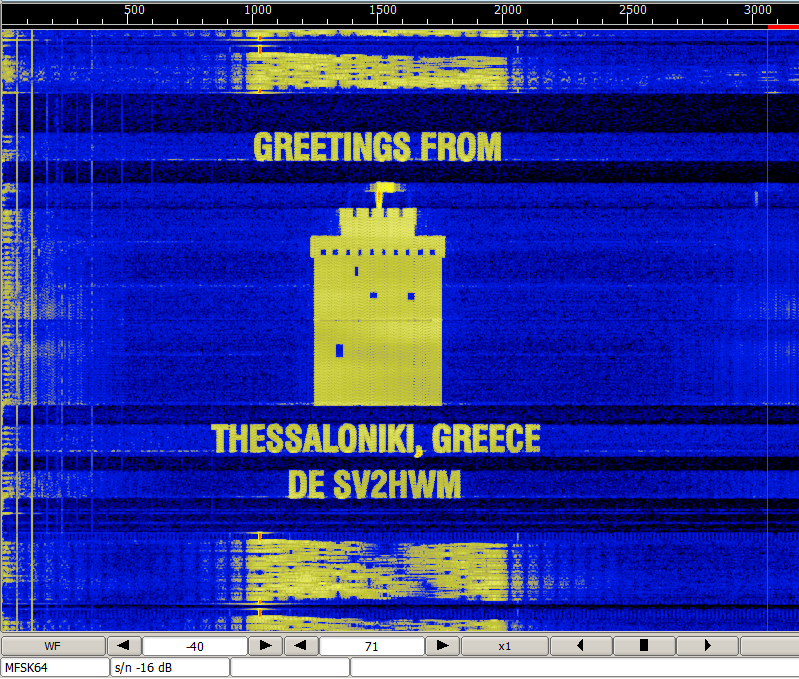
This is Shortwave Radiogram
This week's images ...
Snow and ice on scenic Skyline Drive in Virginia, 16 November.
From bit.ly/2zlYUam ...
https://www.insidenova.com/weather/storm-leaves-an-ice-covered-skyline-drive-parts-of-road/collection_cf2dfd4c-eccd-11e8-9b3b-e7b348461ed6.html#1

Sending Pic:222x161C;
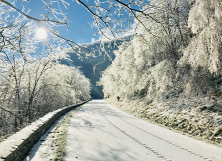
Screen capture from a video of a waterspout in Italy. From
bit.ly/2DCZKT3 ...
Sending Pic:157x299;
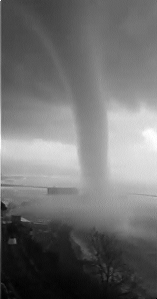
Over the Jefferson Memorial, the Antares rocket taking supplies
to the ISS is seen on launch from the NASA Wallops Flight
Facility on the Virginia coast, 175 km southest of Washington, 17
November. From
bit.ly/2qZicxF ...
====>
https://c1.staticflickr.com/5/4898/45870048082_cecdfb34f3_k.jpg
Sending Pic:106x232C;
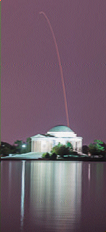
One of the balloons at the Macy's Thanksgiving Parade in New
York, where the temperature was minus 7C. From
bit.ly/2SagMMt ...
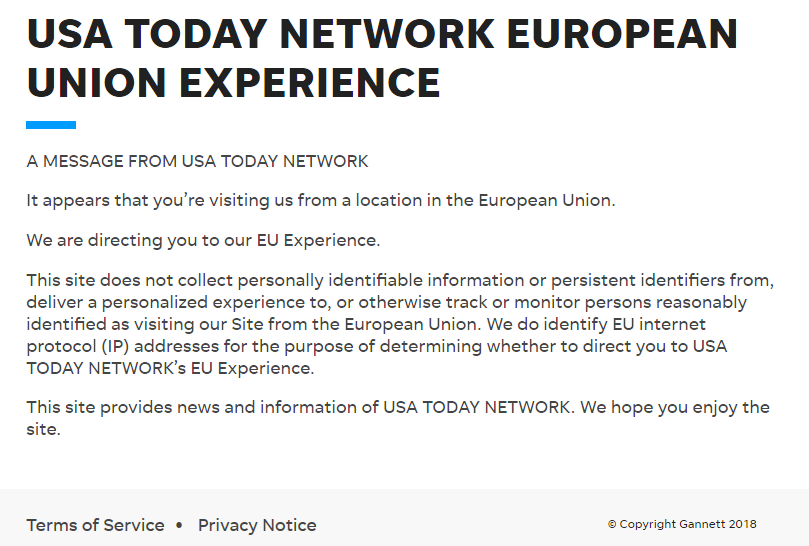
Sending Pic:186x223C;
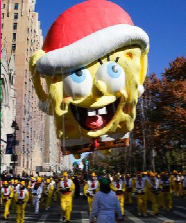
Our painting of the week, by Tommy Beers, depicts the last leaves
of autumn. From bit.ly/2QdhU4n ...
Sending Pic:227x157C;
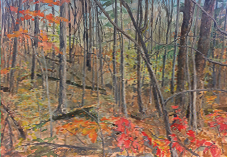
Shortwave Radiogram now returns to MFSK32 ...
RSID: <<2018-11-23T20:57Z
MFSK-32 @
7780000+1500>>
This is Shortwave Radiogram in MFSK32 ...
Transmission of Shortwave Radiogram is provided by:
WRMI, Radio Miami International, http://wrmi.net
and
Space Line, Bulgaria, http://spaceline.bg
Please send reception reports to
radiogram@verizon.net
And visit http://swradiogram.net
Twitter:
@SWRadiogram
I'm Kim Elliott. Please join us for the next Shortwave
Radiogram.
http://www.rhci-online.net/radiogram/radiogram.htm
|
QTH: |
D-06193 Petersberg (Germany/Germania) |
|
|
Ant.: |
Dipol for 40m-Band & Boomerang Antenna 11m-Band |
|
|
RX for RF: |
FRG-100B + IF-mixer & ICOM IC-R75 + IF-mixer |
|
|
Software IF: |
con STUDIO1 - Software italiano per SDR [S-AM-USB/LSB] + beta 11 Version 2.80 (August 21, 2018) - for scheduled IF-recording |
|
|
Software AF: |
Fldigi-4.0.18 + flmsg-4.0.7 images-fldigifiles on homedrive.lnk |
|
|
OS: |
German XP-SP3 with support for asian languages |
German W7 32bit + 64bit |
|
PC: |
MEDION Titanium 8008 (since 2003) [ P4 - 2,6 GHz] |
MSI-CR70-2MP345W7 (since2014) [i5 -P3560 ( 2 x 2,6GHz) ] |
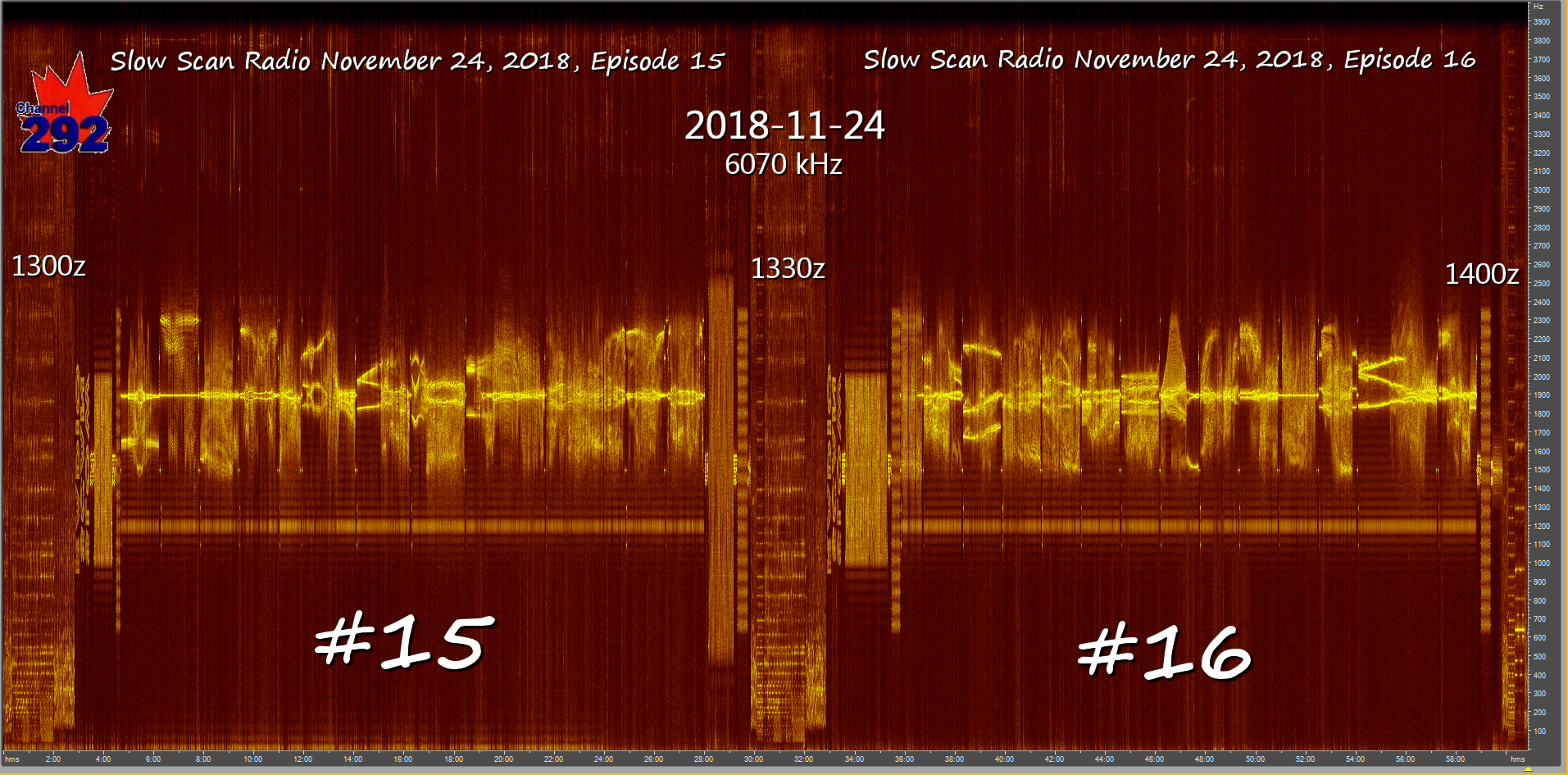
RSID: <<2018-11-24T13:33Z
MFSK-64 @
6070000+1500>>
RSID: <<2018-11-24T13:33Z
MFSK-64 @
6070000+1500>>
Slow Scan Radio November 24, 2018, Episode 16
Third week on a Saturday afternoon this week. The first time we where on two
frequencies. Reports that time were a modest number. Last week we got a lot of
response. A lot of questions
also.
I want to expressly thank all those who are relatively new to our hobby,
especially Mek from Zilina, Slovakia and also Dennis and his CB colleague from
Blomberg in Germany, who stumbled
upon the broadcast by accident, and had a very good reception of most images
when he recognised that it was SSTV what he heard.
--
I am are aware that with the broadcast during daytime, listeners that are at a
larger distance, will have a weaker or even no signal. A solution for that would
be a second time slot, but
at the moment that is still a bit to much of en expense.
A possibility for this would be if listeners that are willing to sponsor part of
the costs for the show could spend a small amount towards the costs. This is
already possible by donating
a really modest amount of for example only 50 cents, or 1 euro per week. If more
more listeners are prepared to sponsor this way this would be a possibility. I
don't need to have the
complete amount of the extra time-slot sponsored, if I receive half the money
sponsored, I will provide for the other half myself.
If you want help me in this way, you can send the amount via PayPal at the
regular mail address x@xdv.me .
I did do a call like this before in September, and a few people donated larger
amounts than 1 euro then. This call for sponsoring in September was meant to do
the show from a location in
the USA then, for example at WRMI. Airtime there however is costing a lot more
than at Channel 292, also because of the higher transmitter power.
Let's try to do this in a modest way, and see if there are enough listeners
willing to sponsor a time slot on 7440 kHz on or near our old slot on Wednesday
evenings.
By the way, internet facilities and studio equipment of the show are sponsered
by www.70MHzshop.nl
--
About the images:
This week almost only PD90 (there's only one PD180 as an exception). If it all
fits within the final mix, we have as much as 14 images this week.
--
After the pictures you will find a list of what's in the pictures and copyright
info.
de PA0ETE k
RSID: <<2018-11-24T13:35Z 20xPSK63R @ 6070000+1500>>
RSID: <<2018-11-24T13:35Z 20xPSK63R @ 6070000+1500>>
Slow Scan Radio November 24, 2018,
Episode 16
Third week on a Saturday afternoon this week. The first time we where on two
frequencies. Reports that time were a modest number. Last week we got a lot of
response. A lot of questions
also.
I want to expressly thank all those who are relatively new to our hobby,
especially Mek from Zilina, Slovakia and also Dennis and his CB colleague from
Blomberg in Germany, who stumbled
upon the broadcast by accident, and had a very good reception of most images
when he recognised that it was SSTV what he heard.
--
I am are aware that with the broadcast during daytime, listeners that are at a
larger distance, will have a weaker or even no signal. A solution for that would
be a second time slot, but
at the moment that is still a bit to much of en expense.
A possibility for this would be if listeners that are willing to sponsor part of
the costs for the show could spend a small amount towards the costs. This is
already possible by donating
a really modest amount of for example only 50 cents, or 1 euro per week. If more
more listeners are prepared to sponsor this way this would be a possibility. I
don't need to have the
complete amount of the extra time-slot sponsored, if I receive half the money
sponsored, I will provide for the other half myself.
If you want help me in this way, you can send the amount via PayPal at the
regular mail address x@xdv.me .
I did do a call like this before in September, and a few people donated larger
amounts than 1 euro then. This call for sponsoring in September was meant to do
the show from a location in
the USA then, for example at WRMI. Airtime there however is costing a lot more
than at Channel 292, also because of the higher transmitter power.
Let's try to do this in a modest way, and see if there are enough listeners
willing to sponsor a time slot on 7440 kHz on or near our old slot on Wednesday
evenings.
By the way, internet facilities and studio equipment of the show are sponsered
by www.70MHzshop.nl
--
About the images:
This week almost only PD90 (there's only one PD180 as an exception). If it all
fits within the final mix, we have as much as 14 images this week.
--
After the pictures you will find a list of what's in the pictures and copyright
info.
de PA0ETE k
RSID: <<2018-11-24T13:58Z 20xPSK63R @ 6070000+1500>>
RSID: <<2018-11-24T13:58Z 20xPSK63R @ 6070000+1500>>
Description of the pictures and copyright info
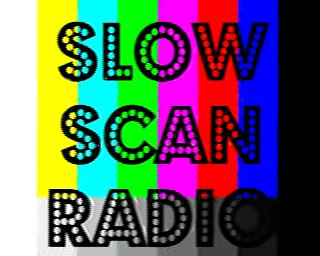
#1
Drone, DJI Phantom 3 Advanced
Copyright info: Licensed under the Creative Commons Attribution-Share Alike 4.0
International license.
Author: Jacek Halicki
#2
DJI Phantom 2 Vision+ V3
Copyright info: Licensed under the Creative Commons Attribution-Share Alike 4.0
International license.
Author: Capricorn4049
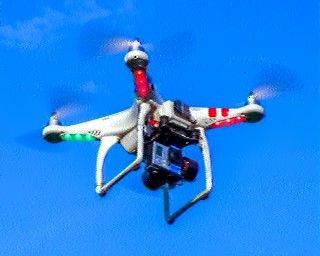
#3
Copyright info: Licensed under the Creative Commons Attribution-Share Alike 4.0
International license.
Author: pics
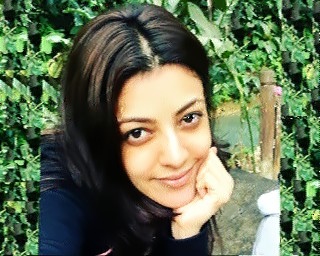
#4
Norway Hiking
Copyright info: Licensed under the Creative Commons Attribution-Share Alike 4.0
International license.
Author: CanSoccer
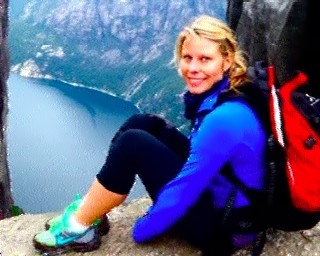
#5
Home made model airplane 'Taxi' with gasoline motor
Copyright info: Licensed under the Creative Commons Attribution-Share Alike 3.0
Unported license.
Author: Rasbak at Dutch Wikipedia
#6
American Water Spaniel Puppie 'Scout'
Copyright info: Licensed under the Creative Commons Attribution-Share Alike 4.0
International license.
Author: WendyMAllen
#7
American Water Spaniel Puppies
Copyright info: Licensed under the Creative Commons Attribution-Share Alike 4.0
International license.
Author: WendyMAllen
Picture number #7 was not transmitted.
In contrast,
the test pattern image right at the beginning was not mentioned in the imprint.
Together, it was again the 14 pictures, so no one noticed this.
#8
Acoustic Sunrise!
Copyright info: Licensed under the Creative Commons Attribution-Share Alike 4.0
International license.
Author: GAllen67
#9
Español: Biblioteca
Copyright info: Licensed under the Creative Commons Attribution-Share Alike 4.0
International license.
Author: David2284
#10
Español: Estación del Ferrocarril de Madrid
Copyright info: Licensed under the Creative Commons Attribution-Share Alike 4.0
International license.
Author: Junitos ramos yanguma
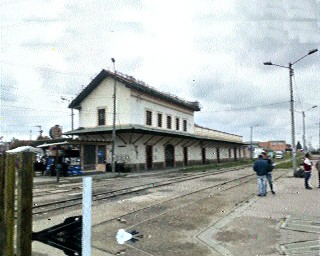
#11
Sinius (BW)
Copyright info: Licensed under the Creative Commons Attribution-Share Alike 4.0
International license.
Author: Daljitkundi
#12
Copyright info: Licensed under the Creative Commons Attribution-Share Alike 4.0
International license.
Author: Dylan Nordwall
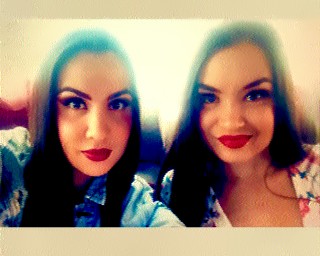
#13
Canal Grande and Rialto Bridge, Venice
Copyright info: Licensed under the Creative Commons Attribution-Share Alike 4.0
International license.
Author: Martin Falbisoner
#14
Fondaco dei Turchi Venice
Copyright info: Licensed under the Creative Commons Attribution-Share Alike 4.0
International license.
Author: Didier Descouens
de PA0ETE k
RSID: <<2018-11-24T13:59Z Feld Hell @ 6070000+1500>>
RSID: <<2018-11-24T13:59Z Feld Hell @ 6070000+1500>>
